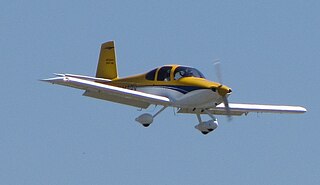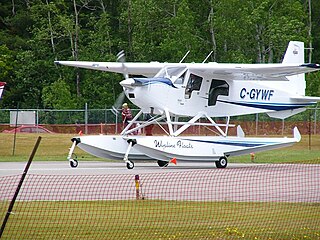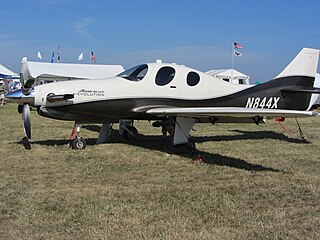
The Piper PA-23, named Apache and later Aztec, is an American four- to six-seat twin-engined light aircraft aimed at the general aviation market. The United States Navy and military forces in other countries also used it in small numbers. Originally designed as the Twin Stinson in the 1950s by the Stinson Aircraft Company, Piper Aircraft manufactured the Apache and a more powerful version, the Aztec, in the United States from the 1950s to the 1980s.

The Piper PA-24 Comanche is an American single-engine, low-wing, all-metal monoplane of semimonocoque construction with tricycle retractable landing gear and four or six seats. The Comanche was designed and built by Piper Aircraft and first flew on May 24, 1956. Together with the PA-30 and PA-39 Twin Comanches, it made up the core of Piper's lineup until 1972, when the production lines for both aircraft were destroyed in the 1972 Lock Haven flood.

The Bearhawk, now also called the Bearhawk Four, is an American amateur-built aircraft, designed by Bob Barrows and produced by Bearhawk Aircraft of Fairview, OKlahoma. The aircraft is supplied as a kit or as plans for amateur construction.

The Pitts Special is a series of light aerobatic biplanes designed by Curtis Pitts. It has accumulated many competition wins since its first flight in 1944. The Pitts biplanes dominated world aerobatic competition in the 1960s and 1970s and, even today, remain potent competition aircraft in the lower categories.

The American Champion 8KCAB Decathlon and Super Decathlon are two-seat fixed conventional gear light airplanes designed for flight training and personal use and capable of sustaining aerobatic stresses between +6g and −5g. The Decathlon entered production in the United States in 1970 as a more powerful and stronger complement to the American Champion Citabria line of aircraft.

The Van's Aircraft RV-10 is a four-seat, single-engine, low-wing homebuilt airplane sold in kit form by Van's Aircraft. It is the first four-seat airplane in the popular RV series. The RV-10 first flew on 29 May 2003, and the first kit parts were delivered to a customer in September 2003.

The Found FBA-2 is a 1960s Canadian four/five-seat cabin monoplane that was produced by Found Aircraft.

The Call-Air Model A is an American two- to three-seat utility aircraft designed by the Call brothers and built by the Call Aircraft Company, later developed into a successful line of agricultural aircraft.

The Lancair Evolution is an American pressurized, low wing, four-place, single engine light aircraft, made from carbon fiber composite, developed by Lancair and supplied as an amateur-built kit by Evolution Aircraft.

The Spencer Amphibian Air Car is an American light amphibious aircraft. The name was first used in 1940 for a prototype air vehicle that developed into the Republic Seabee. The name was later used by its designer Percival Spencer for a series of homebuilt amphibious aircraft roughly based on the Seabee design.

The Dream Tundra is a single-engine, high-wing monoplane designed in Canada. Seating four, its short takeoff and landing characteristics can be adapted to land, snow, or water use. It is produced as a kit for homebuilding.

The Socata TB is a series of light single-engine piston aircraft developed and manufactured by French aircraft company SOCATA. The letters TB within the designation stand for Tarbes, the French city where the aircraft series is manufactured. The TB series planes have come to be known as the "Caribbean Planes" due to the island naming convention adopted for the various models, though they are not often seen flown in that region.

The Barrows Bearhawk Patrol is a two-seat aircraft, that was designed to meet United States homebuilt aircraft category requirements. It was developed from the four-seat Barrows Bearhawk.

The Aviamilano F.14 Nibbio is a four-seat, single engine cabin monoplane built in Italy in the late 1950s. Only ten production aircraft were completed.

The Trident TR-1 Trigull is a Canadian amphibious aircraft that was developed by Trident Aircraft of Burnaby, British Columbia and later Sidney, British Columbia. The aircraft was intended to be supplied as a complete ready-to-fly certified aircraft. The company encountered financial difficulties and only three prototypes were ever built.

The Kawasaki KAT-1 is a Japanese primary trainer, seating two in tandem, designed to compete for a Japanese Air Defense Force (JADF) contract in the mid-1950s. Only two were completed.
The CEI Free Spirit Mk II, also called the Cabrinha Free Spirit Mark II and the Cabrinha Model 423, is a three-seat American homebuilt aircraft that was designed by Richard Cabrinha and produced by CEI of Auburn, California, introduced at AirVenture in 1995. The aircraft was intended to be supplied as a kit for amateur construction, but only prototypes seem to have been completed.

The CubCrafters CC19 XCub is an American light aircraft, designed and produced by Cub Crafters of Yakima, Washington, introduced in June 2016. The aircraft is supplied complete and ready-to-fly.
The Normand Dube Aerocruiser 450 Turbo is a six-seat Canadian amateur-built aircraft, designed by Normand Dube and produced by Aviation Normand Dube of Sainte-Anne-des-Plaines, Quebec. The aircraft is a development of the four-seat Norman Dube Aerocruiser Plus.

The Murphy Yukon is a Canadian amateur-built aircraft, produced by Murphy Aircraft of Chilliwack, British Columbia, introduced at the AirVenture show in 2007. The aircraft is supplied as a kit for amateur construction.


















